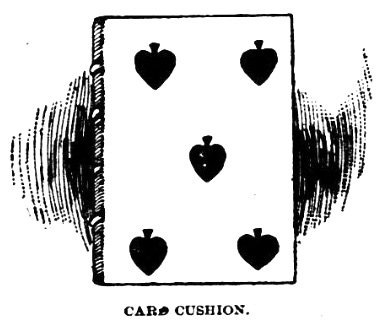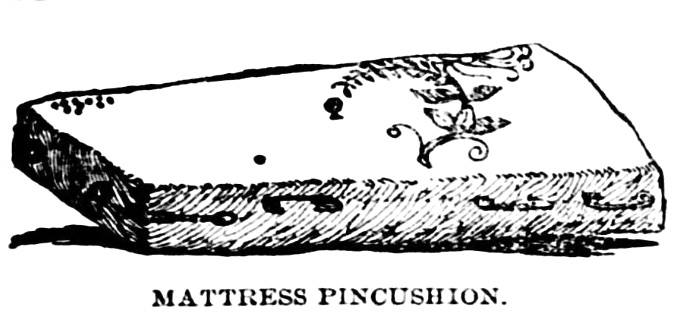
Mattress shaped pincushions were apparently fashionable in 1898, and according to a few newspaper accounts, the playing card pincushion was the thing for women to make.
Neat Pincushions
Needlework, though pursued more industriously at some times than at others, has all the seasons for its own. The stream of fancy work flows on unceasingly, bringing over new attractions. Among unique things fashioned of late in that standard and always useful article the pincushion are those made with playing cards.

For these, get a small glazed pack of cards, size about two inches, and use two for each cushion. The inside is made by covering two pieces of thin cardboard, cut to the exact size of the playing cards, with thin cambric or muslin.
Sew these neatly together and then stick the outer cards on each side, using either fish glue or white of egg.
Mattress pincushions are now the most distinctly popular of the whole tribe. They can be made in any materials, may be embellished with more or less embroidery and are made in various sizes, oblong or square. A desirable size would be 9 by 6 inches.
Having decided on the size, the stuffing and lining must be done, and for this get coarse flannel, which must be cut carefully and exactly to the size of the mattress. It takes several yards of flannel, as it must be very firm and hard, and when all pressed together should be quite an inch thick.
These layers must be firmly sewed together, as the success of these pincushions entirely depends on their being firm and hard at top, at bottom and at the sides.

Another necessity is the perfect regularity with which they are cut, the edges generally requiring to be sheared with very sharp scissors. It is possible to stuff the lining with horsehair or bran instead of flannel, in which case the covering must be made first; otherwise sew the flannel into a case of cheap loose woven muslin, through which the pins pass easily, using tape an inch wide for the sides.
Having completed this, the outer covering is a matter of taste, but plain materials are best. A good satin, silk, or moire looks well, and indeed some of the finest flax linens of pale shades come out well when embroidered in white. A small design in one corner looks well worked in silks, with gold and silver thread, and a few beads or spangles if liked, but keep the embroidery to one color.
There is no need to describe how to proceed, except that in putting the side pieces on they must be even, well stretched and tacked before oversewing with fine silk. These mattresses will take pins of every size.
Source: The Progress. (Shreveport, La.), 19 Feb. 1898.

